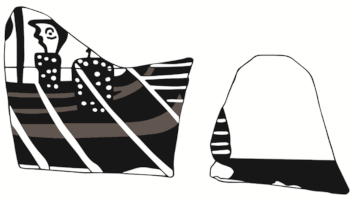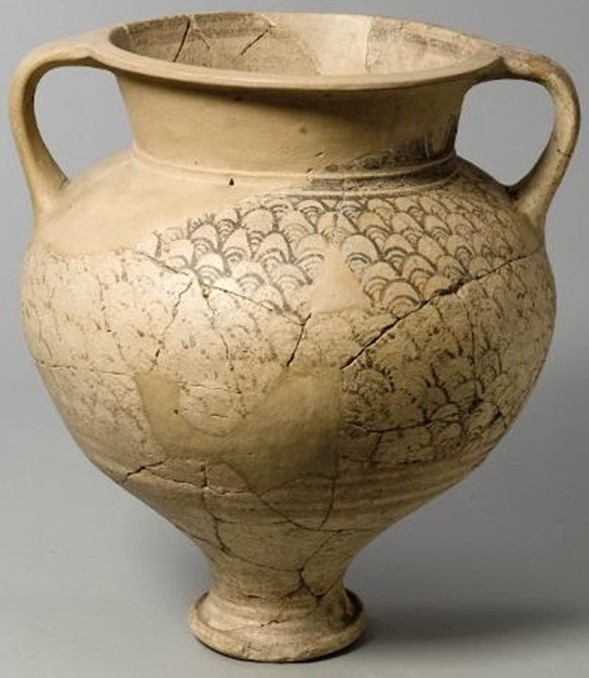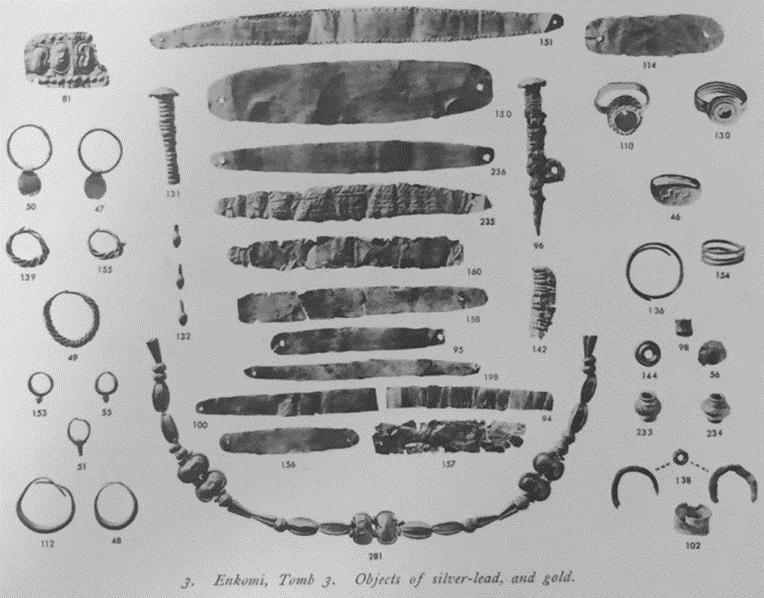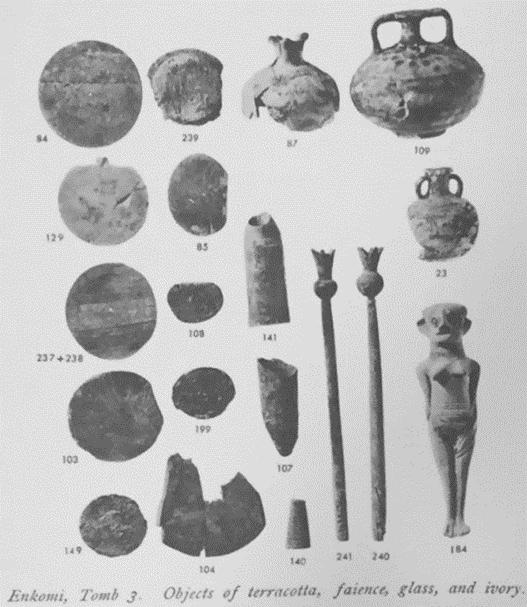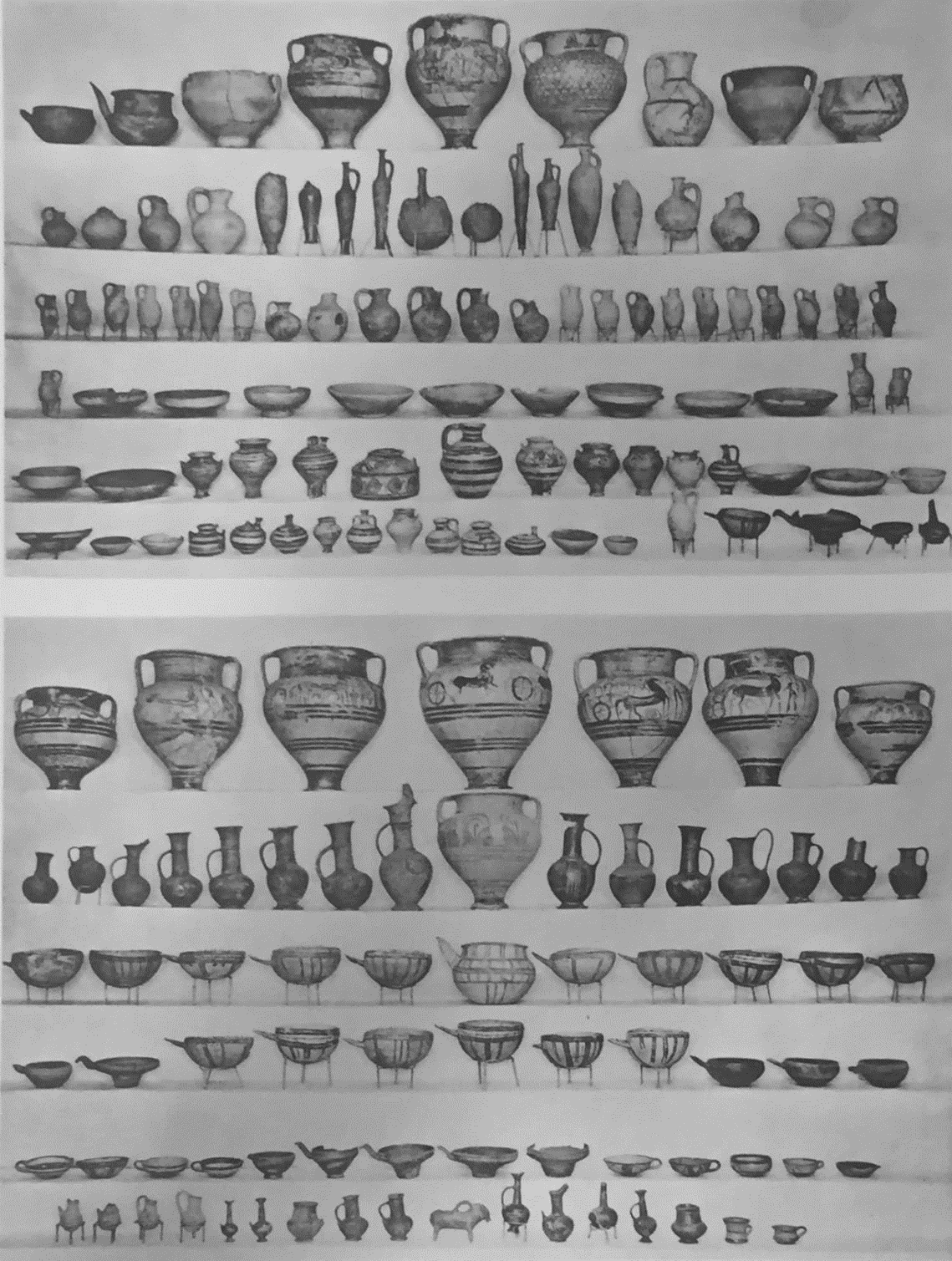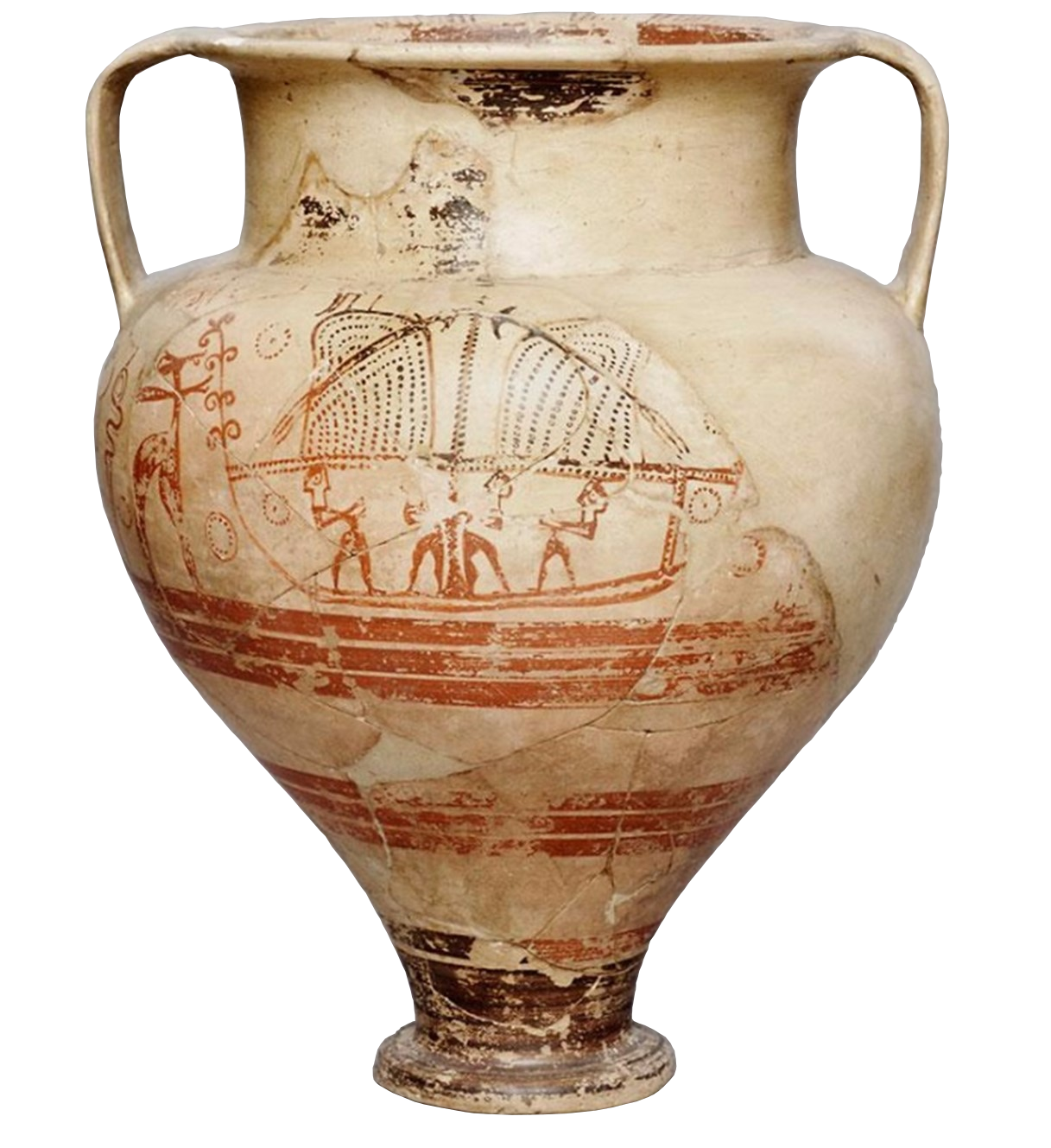Both ships are identical, with the left one being better preserved. The only small differences are the right one having a slightly narrower stern and an additional set of volutes on the sternpost. Flat hull with ship facing to the right, with posts rising at sharp angles and curving outwards at the ends. The stern is decorated with three to four sets of volutes (probably lilies), while the stem has a water bird perched atop. The major elements of the hull (keel, deckline) are rendered using a double line of enclosing dots. The mast rises amidship and is decorated with bumpy lines that may indicate wooldings. Three dead-eyes. There is a reserved compartment at the bow.
Two ships
C1
LH IIIB1 (1300-1250 B.C.)
Enkomi, Swedish Tomb 3
H: 46. 8 cm (of fragment); L: 30 cm (of hulls); H: 15.6 (to masthead)
Amphoroid krater with piriform body, cylindrical neck, horizontal rim, wide flat handles and a disc-shaped foot. Red lustrous paint. Import from the Peloponnese
Stockholm Medelhavsmuseet MM E.3.262
Basch 1987: 147-148, no. 311; Casson 1971: 36; Gjerstad et al 1934: 477-85 (tomb); Keswani 2007: 235 (tomb); Kirk 1949: 116-117; Knapp 2019: 144, fig. 38; Morrison and Williams 1968: 11, no. BA 8; Papadopulos 2018: 525, 528, fig. 4; Vermeule and Karageorghis 1982: 202, no. V.38; Wachsmann 1981: 198-200, fig. 14a; 1998: 142-43, fig. 7.28a; 2013: fig. 2.38; Wedde 1999b: 467 + pl. LXXXVIII, A1-2; 2000: 324, no. 644; Yon and Sauvage 2015: 77, 87, fig. 3c
Swedish tomb 3 was partly looted in Byzantine times, with only a small section of the tomb left intact (layer 5). The tomb was used over a very long period of time, dating to LCIB-LCIIC, with a minimum of 15 individuals buried. For well-preserved Enkomi tombs dating to LCI-LCIIC, it has the third largest floor area (7.3 m2) and ranks fourth for wealth in gold. It is also part of six tombs at Enkomi with the largest amount of Mycenaean pottery (54 pots). The concentration of Mycenaean kraters is particularly noticeable, since usually these are found singly or in small numbers (2-4). Besides costly materials and the large number of imports, there also elite symbols such as the figure of eight shield and the poppy head for the ivory pins.
Krater scene: Two identical ships to the right, with four small figures below deck arranged antithetically in pairs, two antithetical warriors on deck and two more on a larger scale framing each ship. The warriors on deck wear helmets and mantles, and carry tasseled and pommeled swords in their scabbards. The warriors framing the ships are dressed in the same manner. Dotted circle decorations below deck and outside. Groups of encircling bands on the lower body.
The ship is at least partially decked. There is no rigging depicted, but the artist supplies evidence to indicate that the boom-footed rig from the mast cap was still in use. The curving sternposts with lily decorations resemble somewhat a stem device on a ship from Phylakopi. There is significant disagreement about the reliability of this artistic representation, with the majority view tending to reject the Enkomi krater as reliable ship architectural evidence (Wedde 2000: 98-99 for discussion). Wachsmann bases his objection on the heraldic arrangement of all the figures, as well as the conventional posture of the men, including those below deck, which suggests artistic considerations rather than an actual depiction of their activity on the ship (Wachsmann 1998: 143). The hull is considered to be altered considerably, and there is also disagreement as to whether this is a merchantman or a warship. Wedde argues that the ships represent a galley, albeit modified somewhat by the artist. The presence of warriors suggests at the very least a mixed function. The elements adorning the warriors resemble those of the warriors depicted on shore of the miniature frieze from Thera.
Basch, L. 1987. Le musée imaginaire de la marine antique. Athens: Institut Hellénique pour la preservation de la tradition nautique.
Casson, L. 1971. Ships and Seamanship in the Ancient World. Princeton: Princeton University Press.
Gjerstad E. 1934. The Swedish Cyprus Expedition. Vol I. Stockholm: the Swedish Cyprus Expedition.
Keswani, P. 2007. Mortuary Ritual and Society in Bronze Age Cyprus. London: Equinox.
Kirk, G.S. 1949. “Ships on Geometric Vases.” BSA 44: 93-153, pls. 38-40.
Knapp, A. B. 2018. Seafaring and Seafarers in the Bronze Age Eastern Mediterranean. Leiden: Sidestone Press.
Morrison, J.S. and R.T. Williams. 1968. Greek Oared Ships: 900-322 B.C. Cambridge: Cambridge University Press.
Papadopoulos, A. 2018. “The Iconography of Late Helladic IIIA-B Pictorial Kraters and Wall-paintings: A View from the Aegean and the Eastern Mediterranean,” In A.Vlachopoulos (ed.) Paintbrushes. Wall-Painting and Case-Painting of the Second Millennium BC in Dialogue. Athens: Hellenic Ministry of Culture and Sports, pp. 523-531.
Vermeule, E. and V. Karageorghis. 1982. Mycenaean Pictorial Vase Painting. Cambridge, Mass.: Harvard University Press.
Wachsmann, S. 1981. “The Ships of the Sea People,” IJNA 10: 187-220.
―――. 1998. Seagoing Ships & Seamanship in the Bronze Age Levant. College Station, TX: Texas A&M University Press.
―――. 2013. The Gurob Ship–Cart Model and Its Mediterranean Context. College Station: Texas A&M University Press.
Wedde, M. 1999b. “War at Sea: The Mycenaean and Early Iron Age Oared Galley,” in R. Laffineur (ed.) Polemos: Le context guerrier en Égée à l’âge du bronze. Actes de la 7e Rencontre égéenne internationale, Université de Liège, 14–17 Avril 1998. Aegaeum 19. Liège: Université de Liège, pp. 465–427.
―――. 2000. Towards a Hermeneutics of Aegean Bronze Age Ship Imagery. Peleus Studien zur Archäologie und Geschichte Griechenlands und Zyperns, vol. 6. Bibliopolis: Mannheim and Möhnsee.
Yon, M. and C. Sauvage. 2015. “La navigation en Méditerranée orientale à l'Âge du Bronze Récent,” in : B. Argémi and P. Tallet (eds.) NeHeT 3. Entre Nil et mers : La navigation en égypte ancienne. Actes des rencontres de Provence Égyptologie Musée Départemental Arles Antique le 12 avril 2014, pp. 73-103.


